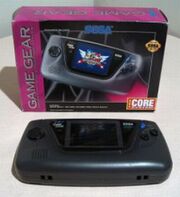Template:Handheld Platform Top

Game Gear
The Sega Game Gear is a handheld game console which was Sega's response to Nintendo's Game Boy. It was the third commercially available color handheld console, after the Atari Lynx and the Turbo Express.
Work began on the console in 1989 under the codename "Project Mercury", as per Sega's policy at the time of codenaming their systems after planets. The system was released in Japan on October 6, 1990, in North America and Europe in 1991, and in Australia in 1992. The launch price was $149.99. Sega dropped support for the Game Gear in early 1997.
Features
Games
Over 250 titles were released worldwide for the Game Gear, although at the time of the console's launch there were only six software titles available. Sega made sure that a wide variety of video game genres were represented on the system, in order to give it a broad appeal. Prices for game cartridges initially ranged from $24.99 to $29.99 each. They were molded black plastic with a rounded front for convenient removal. The original Game Gear pack-in title was Columns. It was similar to the Tetris cartridge that Nintendo had included when it launched the Game Boy.
Popular titles included Sega's own series, notably Sonic the Hedgehog, Disney movie extensions, such as The Lion King, and 3rd-party developer games like Mortal Kombat.
In an unusual step, Sega decided not to region encode Game Gear cartridges, meaning that any system could play any games regardless of the country they were released in. This practice helped to make the console popular among import gamers. An exception to this universal compatibility is the TV Tuner accessory, which will not work in regions it was not designed for due to differences in TV broadcast signals in different countries.
Design
The Game Gear was basically a portable Master System with a lower resolution screen, but allowed for a larger color palette, and therefore better-looking graphics. In addition, it could also produce stereo sound (through headphones) as opposed to the Master System's monaural output, although very few games made use of the stereo capabilities. Unlike the original Game Boy, the system was held in a "landscape" position, with the controls at the sides, making it less cramped to hold.
Sega had taken a similar approach when developing the Sega Mega Drive, basing it on Sega's 16-bit arcade hardware. This enabled direct conversion of popular games. Likewise, because of the similarities between the Master System and the Game Gear, it was possible for Master System games to be written directly onto ROMs in Game Gear cartridges.
Variations
The blue Game Gear sports edition, identical to the standard Game Gear, except in body color, was released in 1993, with the game World Series Baseball. Another specialty edition was a red Coca-Cola-themed Game Gear unit, released to the Japanese market, which came with a game entitled Coca-Cola Kid. In Japan, Sega also introduced Kids Gear. It was a repackaging of the Game Gear system in a different color case. Software advertised for Kids Gear focused more on children's game titles. Kids Gear was never released in the United States.
